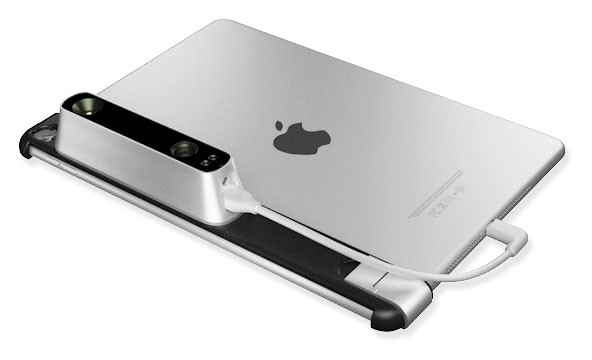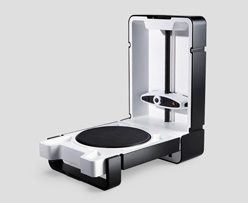3D Scanning
A 3D scanner is a device that analyzes a real-world object or environment to collect data on its shape and its appearance (like color). The collected data is then used to construct a 3D model.
3D scanners are great for getting a rough sketch of an object; however, they should be used for reverse engineering a part. This is for two big reasons: the accuracy of the scan and the usability of the resulting model. Both of these are a pretty big deal and are keeping 3D scanners from being particularly useful in engineering applications.
The accuracy issue is one which you can probably see the problem with pretty easily. Even high-quality scanners tend to result in imperfect models. That’s especially true for complicated parts or parts with any internal geometry.
Because 3D scanners work optically, they can only scan what they can see. If there is any internal geometry, the scanner wouldn’t be able to see it. So that geometry wouldn’t be replicated and would be lost.3D scanners can build IT offers access to 3D scanners and post-processing software.
build IT offers access to 3D scanners and post-processing software.
If you want to 3D scan something, here are some questions you need to keep in mind:
- How large is the object?
- What material is the object comprised of?
- How accurate does the scan need to be?
- Are you looking to capture movement?
- Is surface color important?
We can help you work through these questions and help you decide what mode of capturing is best for you
Structure Sensor
by Occipital

Credit: Occipital, Inc.
Self-Service Structured Light 3D Scanning
Structured-light 3D scanning is a process that measures a three-dimensional shape of an object using projected light patterns and a camera system. Projecting a narrow band of light onto a three-dimensionally shaped surface produces a line of illumination that appears distorted from other perspectives than that of the projector, and can be used for an exact geometric reconstruction of the surface shape (light section). This method can be particularly helpful for large-scale objects or subjects like people.
Our Structure Sensor 3D scanner is available on a walk-in basis. A workstation with the Structure Sensor 3D Scanner and its associated software, MF Scan, is available within build IT. The documentation available through Skanect will walk users through the the step-by-step process of creating a 3D scan. Resulting models can be exported from MF Scan as STL, OBJ, VRML, and PLY format.
For a good product review, watch the "Tested In-Depth" video.
Learn more at https://structure.io/getstarted
Matter and Form 3D Scanner
by Matter and Form

Credit: Matter and Form, Inc.
Self-Service Laser Scanning
The Matter and Form 3D Scanner is a laser-based scanner. Laser scanners work by shining a laser at an object, using a camera to capture data that is returned from the laser hitting the surface of an object and then using software to stitch all that data together. On the Matter and Form scanner, as the lasers pass over the surface of an object, data is generated at a rate of approximately 2,000 points per second. This data is comprised of thousands of individual points that record things like surface detail, distance from the camera, texture, and color. These thousands of points, when viewed collectively, form a “point cloud” that is a direct representation of the scanned object.
Our Matter and Form 3D scanner is available on a walk-in basis. A workstation with the Matter and Form scanner and its associated software, MF Scan, is available within build IT. The documentation available through MF Scan will walk users through the the step-by-step process of creating a 3D scan. Laser scanners like the Matter and Form 3D Scanner may be ideal for smaller objects that require high precision. Resulting models can be exported from MF Scan as STL, OBJ, XYZ, MFCX, and PLY format.
For a good product review, watch the "Tested In-Depth" video.
Learn more at https://matterandform.desk.com/?
Photogrammetry

"camera" flickr photo by Plastic_Bat https://flickr.com/photos/plasticbat/2248522722 shared under a Creative Commons (BY-NC-ND) license
Self-Service and Guided, Photo-Based Capturing
Photogrammetry is a process that can be done within your own home if you have access to a digital camera. Objects with a lot of surface detail work great with this method, as the algorithm that generates a model analyzes your photos on a per-pixel basis, looking for features it can identify across 2 or 3 photographs. If it can locate the same feature across several photographs, that feature can be triangulated in 3D space, allowing a model to be constructed from a plotted point-cloud.
We offer a guide to walk you through taking 360-degree photos, and within build IT, we provide a variety of software that can be used to process your photos. For more accurate results, we also have a method of capturing objects or people on a turn-table within in the lab. This can be particularly helpful for large-scale objects or subjects like people (that move slightly and need to be photographed quickly).
The process of Photogrammetry has the ability to preserve very high-resolution color information as the photos used in generating a model are mapped to the model’s surface and depending on the subject, the precision of the resulting model can sometimes rival that of a laser scanner. Models and point cloud data generated through Photogrammetry can be exported as OBJ, PLY, EXY, ASPRS LAS, STL, FBX, Adobe PDF, 3DS, COLLADA, Autodesk DXF & U3D format.
Getting Started
Software
- Meshmixer is a free tool for creating and editing 3D models. Meshmixer can create files in .STL and .OBJ formats, and these files can then be printed using any of build IT's 3D printers.
- Meshlab for editing polygonal meshes and point clouds. MeshLab is open source! Download for free.
- Skanect for use with the Structure Sensor
- MF Scan for use with the Matter and Form 3D Scanner
Resources
- Safari Tech Books a wealth of technology-related books. Search for 3D scanning. RedID required for access.
